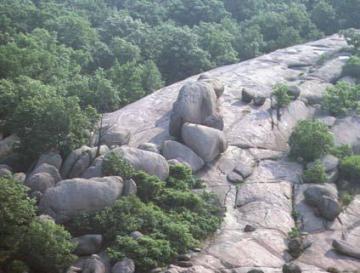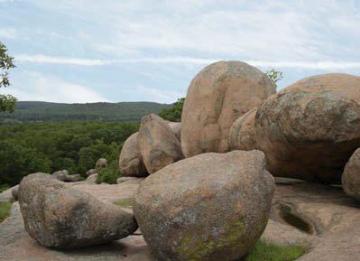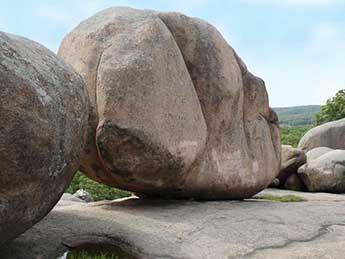
A Geologic Phenomenon
How would you like to see a herd of pink elephants that are more than a billion years old and not extinct? You’ll find them south of Highway 21 at the northwest edge of Graniteville in Iron County.

These ancient pachyderms aren’t performing in a circus or living in a zoo because they are huge elephant-shaped igneous rocks crowning the high point of Elephant Rocks State Park. The herd of pink granite “elephants” weighs about 160 pounds per cubic foot and stands 20 to 30 feet tall. “Dumbo,” the matriarch of the troop, weighs about 680 tons, stands 27 feet tall, and measures 35 feet long and 17 feet wide. She and her family of spherical, egg-like masses of eroded pink granite were created by the same forces that produced the Ozark Mountains.
More than a billion years ago hot granite magma, which is molten rock material generated within the earth, was forced upward into the earth’s crust where it cooled and crystallized while still below the surface. Later, vertical cracks called “joints” developed in these masses of solidified magma when movement occurred in the earth’s crust as the Ozark Mountains were being uplifted. Eventually surface erosion, which took millions of years to do its work, stripped away the rock that covered the masses of pink granite, exposing the sharp angular edges of the joints that riddled the granite.

Continuous freezing and thawing, accompanied by the sculpting powers of wind and rain, smoothed and rounded the edges until the elephant-shaped rocks evolved. A close look at the skin of these giants reveals coarse grains of quartz. The stone is chiefly orthoclase, a pinkish mineral with bright, glassy cleavage faces. Other iron-rich minerals are also present, which help give the elephants their color.
Architects and developers discovered the elephants and the thick deposits of granite
bedrock nearby in the 1800s. In fact, the oldest granite quarry in the state opened near
Graniteville in 1869. The granite takes a high polish and is ideal for tombstones and building stone. Granite taken from the site furnished stone for the Eads Bridge and the cobblestone streets of St. Louis. Other quarries north of Elephant Rocks supplied the turned columns on the front porch of the Governor’s Mansion in Jefferson City.
A unique geologic feature as well as a scenic landmark, the Elephant Rocks were eventually purchased from the Heyward Granite Company by retired geologist, Dr. John S. Brown of the St. Joseph Lead Company. In 1966, Dr. Brown deeded the 135-acre site to the state for use as a recreation area and park. A clause in the deed prohibits commercial use of the granite for a period of 99 years. Prior to this, several civic groups in the Ironton-Pilot Knob area maintained and protected the massive rocks for the use and enjoyment of the public.

Dumbo and her unique herd of pink granite elephants are now the reigning monarchs of Elephant Rocks State Park. A trip to visit them is highly recommended for the entire family. And you won’t even have to take along bags of peanuts to make friends with these magnificent giants. A camera is all you need.
